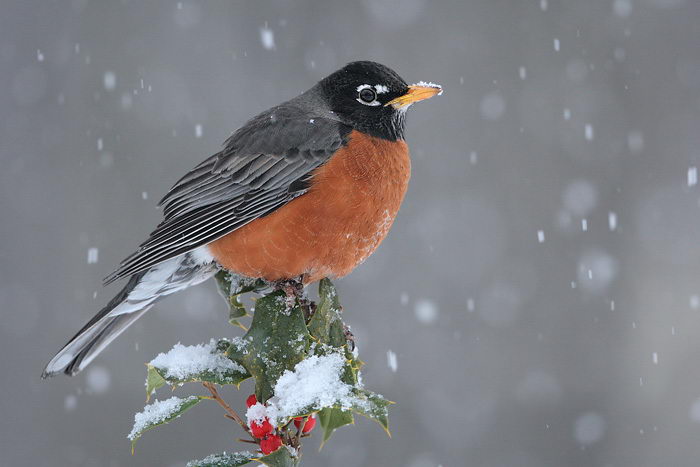The American robin (Ixoreus naevius) is not only the largest thrush of North America but it is also one of the sweetest songbirds. It is known for short-distance migration. The American robins mostly spend winter in their breeding range. The bird is also called redbreast primarily because it has brick-red breast.
Robin Bird Facts
Anatomy
- The American robin weighs up to 2.5 – 3.5 oz with the length measuring around 9 – 11 inches.
- The wingspan of robin measures around 12.2–15.7 in (31–40 cm).
- The robin is one of the rarest birds that show vibrant colors on its plumage—from red breast to white feathers that go around its eyes (almost like glasses).
- The male’s plumage is a little brighter than that of female’s. Besides, the male’s head is also dark and breast.
- The bright orange breast does not become visible in young robins.
- The American robin seems more like a varied thrush (Ixoreus naevius).

Distribution
- The American robins are distributed all throughout the North America, ranging from Alaska through Canada and the United States to Guatemala and Mexico.
- The robins are sighted as vagrants in Jamaica, Puerto Rico, Greenland, and Belize.
Habitat
- While the American robin has occupied almost the entire North America, it prefers to live in the deep forest. The bird makes home in a variety of habitats. Robin bird never limits to a specific area for it is widely distributed in places as varied as sparsely wooded land in the east to mountains 12,000’ above sea level in the western United States.
- The robin bird has adapted to living in suburban, modern, and open regions. At times it is also found in backyards, orchards, city parks, and pastures. Although the American robin fancy living in trees yet it is also spotted in suburban fence, perching site, and fire escape or gutter.
- During winter, many robins will fly to the south to avoid the harsh climate of the north. However, some birds are going to stay in the south and as such they enjoy abundance of berries in the forest.
Behavior
- Scientists are not sure about the migratory patterns of American robins. They will start moving towards north (in February) when the average temperature reaches around 37 degree Fahrenheit.
- In March large flocks of robin males arrive in the northern states. In these flocks males are highly aggressive.
- Each male robin establishes a territory as and when it sees flocks of females approaching. The male and female confront each other in April. Each territory is about an acre in size and it goes smaller in the nesting time.
- The sweet song of the American robins serves as a wake-up morning alarm and it sounds more like a cheerily-cheery-cheerily-cheery. The bird’s song also serves as an evening lullaby. Besides, the American robin also produces sounds because they want to show their territory. They can be aggressive outside territory especially while foraging.
- They do not only feed on the ground but in bushes too. Robins cannot walk; they move in the form of hopping or bouncing.

Feeding Diet and Ecology
- The American robin has a varied diet throughout the year as the food-availability entirely depends on the season. Robins are often found in meadows, golf courses, and backyard lawns in the summer and spring seasons. They search for earthworms which is their favorite appetite during summer.
- They are adept at looking for worm’s tunnels and when they find one robins poke their beak to get the reward.
- Apart from earthworms, robins also consume several insects such as beetles, termites, ants, and weevils. The American robins also feed on butterflies, caterpillars and even quick-hopping grasshoppers.
- During fall, robins are apt to feed on carbohydrate-rich fruits which are necessary to fatten them up and prepare them for cold climate or long migrations.
- A few robins spend winter in north and they are known to consume berries and seeds because these are not covered by snow.
- The American robins enjoy oranges and apples along with the raisins and bread at bird feeders. Old apple orchards offer very useful treats in the extreme cold.
- During spring the male robins will search worms in open grassy areas and they are often found play war games with earthworms.
- The robin’s nest is located well 1.5–4.5 m (4.9–14.8 ft) above the ground.
- The hatchlings will consume worms, berries, and insects.
Reproductive Biology
- The male robin marks the territory while the female begins to nest. The female lays four to five eggs each season. These eggs are sky-blue in color.
- The female builds a nest with grasses and rootlets and later it presses her breast against the edges. The female incubates eggs for about 14 days.
- The young will leave the nest after 13 days.
- The male bird feeds the young while the female builds a second nest in a deciduous tree.
- In summer, days are longer and so the female feeds her young in as much as 21 hours a day.
- They attain the maturity age after 1 year.
- The breeding months last April to August. The young fledges out in 2 – 4 weeks.
- There are 2 – 3 broods per year.
- The lifespan of the American robin is 12 years in the wild and 17 years in captivity.






Leave a Reply